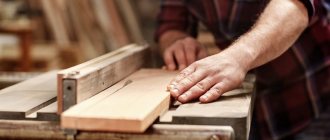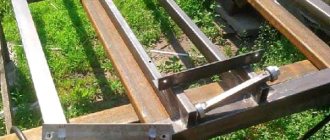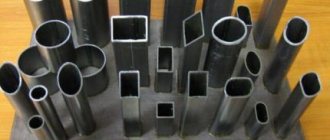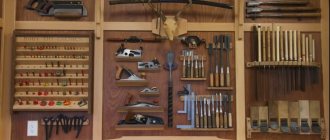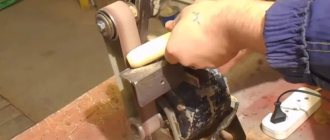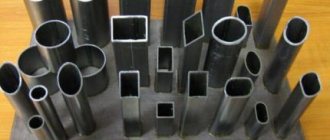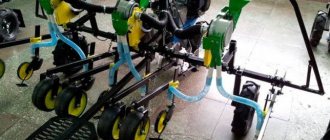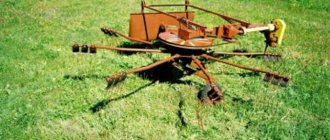Crafting table
Dimensions of the workbench
The height of the surface of the tabletop should be such that a worker can operate tools and equipment while standing. The workshop owner determines the height of the workbench himself - according to his height. The height of the desktop ranges from 75 cm to 80 cm.
The size of the countertop is determined by the area of the utility room. The table should not impede free passage around it.
Workbench material
- Tree. A wooden table is often used. The workbench is made of timber and boards. The legs of the table are secured with diagonal crossbars for reliability.
- Metal. The most reliable workbench design is a workbench welded from a metal profile. Manufacturing a welded product requires having a welding machine and experience working with it.
The table top is made in the form of a shield from knocked down boards using pieces of timber. The shield is rested on the legs of the table and fastened with nails or screws. The connection parts are made from angle steel.
The options for assembling a wooden workbench are different, but they have one thing in common - the table structure must be stable and withstand static and dynamic loads.
If the surface of the workbench will be subject to accidental impact from cutting and sharp tools, then the tabletop is covered with tin or a metal sheet is placed on top.
The supporting frame and table legs are welded from steel angle and strip. For auxiliary parts, pieces of reinforcement are used.
The table top is made of metal sheet, 8 - 12 mm thick. A thick sheet will significantly increase the weight of the workbench, which will make it difficult to move.
Rack of boxes
It is not necessary to use homemade garden drawings to do simple things. Just look at the photos of the finished products. The process of implementing the idea becomes clear. It’s easy to build a useful rack from ordinary fruit boxes. An open closet is useful for both home interior and household purposes.
To make an item, wooden boxes are joined together. This way it will be possible to make a product with any dimensions. It is easier to work with ready-made boxes, but the material can always be replaced with ordinary slats. The frame can be made of metal guides. Such a product will be stronger, more solid, and more interesting in appearance.
Stool
Making a stool with your own hands is quite simple:
- 4 supports, 50 cm long, are made from timber 40 x 40 mm.
- The legs in the middle of the length are fastened with crossbars.
- Grooves are made in the supports using a chisel.
- At the ends of the transverse planks, protrusions are cut out using a chisel to fit the grooves.
- The protrusions are lubricated with wood glue and inserted into the grooves.
- While the glue dries, the supports are tightened with a belt.
- The seat is cut out with a circular saw from a wide board 30 mm thick.
- A seat measuring 300 x 300 mm is nailed or screwed to the legs of the stool.
Mini vise made of metal loop
When performing small operations, small parts often need to be clamped. To do this, use a mini vice made from a one-piece door hinge.
Matching holes are drilled in both hinge flaps.
A bolt of suitable diameter is threaded through them. On the other side, a wing nut is screwed onto the bolt thread. The parts are inserted into the opening between the doors and clamped by tightening the nut. The device can be used as a clamp.
Homemade tools for car repairs
A windshield wiper arm remover is a special tool that facilitates the process of removing wiper arms. You can make it yourself from a piece of reinforcement, a six-channel channel and a ten-bolt. To do this, use a drilling machine to make 14 holes and weld 2 nuts on both sides of the hole and a handle from the fittings, screw the bolt into the workpiece and, putting on heat shrink, screw in the threaded rivet. The tool is ready. Another version of the device for shooting windshield wiper arms is shown in the photo below.
Another useful homemade device with which you can manually re-align your wheels yourself. Another version of this device can be seen in the photo below. When carrying out major car repairs, you usually cannot do without a lift. A device made in a factory is not cheap, and is not needed very often, so it can easily be replaced with a device made at home.
Hammer upgrade
A common occurrence is a wooden handle falling out of the hammer socket. One of the ways to create a reliable handle fastening is to make a cut in the upper end of the handle. The holder is inserted into the hammer socket. The cut is filled with Moment glue. A wooden wedge is driven into the groove.
In order not to look for nails while working, and especially not to hold them with your teeth, a round magnet is glued into the bottom of the hammer handle. Magnetic nails will always be at hand for the worker. It is dangerous for the hammer to accidentally fall out of your hand at height. To prevent this from happening, a hole is drilled in the handle through which the cord is threaded. The worker's belt is threaded through the loop.
Rocky paths
Convenient paths will increase the comfort of the area. Walking along stone paths in the rainy season, you won’t have to get your shoes dirty. It is not necessary to search the fields for natural stones or buy paving slabs. You can create elements of decorative masonry yourself.
Before starting experiments, it is better to watch a video of the process. The finished paths do not have to be left boring gray. Stones on paths can be painted in bright colors. This will add positivity and fun to the space.
Note!
- Weaving willow baskets: beautiful and unusual do-it-yourself baskets. Detailed diagram of willow weaving + photo examples of finished products
DIY gazebo - the best design ideas. Description of construction stages with step-by-step instructions for beginners + 160 photos
- Capers - TOP-150 photos of types, best cooking recipes. Application options and beneficial properties + instructions on how to choose capers
If you use neon paint for coloring, you will be able to observe an unusual glow effect in the dark.
Pipe bender
A device for bending metal pipes is a metal rod welded to the frame. I make the rod from a piece of reinforcement. The pipe is placed on a pin, and on the other side a long piece of reinforcement is inserted into the pipe. By pressing the lever, the pipe is bent at the desired angle. The device is suitable for small sections of round pipes.
Making a pipe bender with your own hands
- Two axles are welded to a metal frame from pieces of smooth reinforcement, onto which old car hubs are placed.
- Protruding chamfers are removed from the hubs so that the side surfaces of the rollers are smooth.
- The channel is placed in the opening between the hubs with the shelves facing up.
- The same profile, smaller in width, with the flanges down, is placed into the channel.
- An axle is welded to the top of the inner profile, onto which the third hub is placed.
- A vertical shelf made of steel sheet is welded to the frame.
- A hole is cut in the vertical bar and the bearing is pressed into it.
- A nut is secured to the middle channel by welding.
- One end of the screw rod is screwed into the nut.
- The screw shank is threaded through a bearing in a vertical bar.
- A rotary handle is welded to the shank on the back side of the bar.
- A swing arm is welded to the axis of the drive hub.
The machine is ready for use. A profile pipe is inserted between the rollers and clamped with a screw. The rotary lever drives the rollers, which pull the pipe, bending it. The bending radius is set using the rotary handle of the screw.
A pipe bender made from car hubs is one of the device options. There are many designs of bending devices. In some models, the drive roller is coaxially connected to the motor shaft.
Table made from an old reel
It’s enough to look through pictures of homemade items for your dacha to find a suitable idea for yourself. Many people do not see the beauty of ordinary garbage without seeing the realized possibilities of its transformation. For example, a wooden cable spool makes an excellent table.
You don't have to make any special efforts to complete the task. The item is almost ready for its new role. All that remains is to treat the surface, making it more aesthetically pleasing and safe.
You can also build a table from pallets. It will be possible to make a product of any scale. In the garden by the pool or sun lounger, a low coffee table will come in handy.
A thing with standard dimensions will replace a dining table. An item with additional internal shelves, ideal for a workshop or garage.
Note!
DIY garden decorations: 150 photos of original ideas and new products. Instructions with step-by-step guidance, diagrams and drawings
- Fast-growing climbing plants for the fence and garden ☘️. Review of perennial and annual plants. Photo + instructions with description
DIY barbecue: TOP 120 photos of the best examples of work. Master class on making at home + simple diagrams and drawings
Impact screwdriver from starter
There are situations when it is impossible to unscrew a rusted bolt or screw with a conventional tool. An impact screwdriver does this job perfectly. The tool is made by hand from parts of a car starter:
- The shaft and bushing are removed from the starter housing.
- Part of the shaft is cut off, leaving a splined rod.
- A piece of pipe of suitable size is placed on the sleeve.
- A piece of bolt of equal diameter is welded to the end of the pipe.
- The end of the shaft is ground into a tetrahedron shape, onto which heads of the required size are placed. For screws, a bit is inserted into the head.
When you hit the head of the bolt with a hammer, the shaft slides with beveled splines inside the sleeve, performing a rotational movement. The stronger the blow, the more force the shaft rotates.
Homemade bow saw
A bow saw is a convenient tool for cutting tree trunks and lumber. The design of the saw is simple; making a hand tool with your own hands is not difficult. To do this you need to prepare tools and materials:
Tools
- drill;
- hacksaw;
- chisel;
- hammer;
- knife.
Materials
- cord;
- wooden slats 20 x 40 mm;
- cotter pins – 2 pcs.;
- stalk ø 10 mm;
- saw blade;
- stain;
- wood varnish.
Step-by-step instructions for making a bow saw
- The lath is cut into three parts (two vertical side strips and a middle horizontal strip).
- Grooves are made in the side handles using a chisel.
- At the ends of the centerpiece, protrusions for grooves are cut out with a chisel.
- The centerpiece is connected to the side handles.
- Through holes are drilled at the joints. Wooden cotter pins are driven into them.
- Cotter pins form hinge joints. This is necessary for the mobility of the lower ends of the side slats when the canvas is tensioned.
- Cuts are made at the lower ends of the sidewalls - parallel to the middle.
- Short bolts are inserted into the holes of the saw blade and tightened with nuts.
- The blade is inserted into the cuts so that the bolts are on the outside of the structure.
- Circular grooves are cut out at the upper ends of the handles.
- Loops are made at the ends of the double cord, which are placed on the grooves.
- A handle is inserted between the strings of the cord, the long end of which rests on the mullion.
- The saw string is twisted using a handle, achieving the desired degree of tension on the saw blade.
- The wood is covered with stain and two layers of varnish.
- After the varnish has dried, the saw is ready for use.
Homemade folding stand
A very original idea for a folding stand for hand tools. Everyone is in their place. It doesn't take up much space. The design is based on furniture guides. The clamp holds the stand in the upper position. Neodymium magnets prevent instruments from falling out of their stocks. A great idea for DIYers who love to do everything with their own hands.
Old rake as an organizer
It's easy to turn an old rake into a garden organizer. The tool is used to store work equipment. You don't have to do anything complicated with the rake. The instrument is raised with its teeth upward. The shaft is stuck into the ground to ensure the stability of the structure. The existing equipment is distributed between the teeth.
Before using the organizer, it is recommended to paint the metal part. This will prevent rust from spreading to working tools.
Cheap homemade grinder
The most budget version of the grinder, created by the Samodelkins. Plastic bottles are used as rollers. They are mounted on bearings. The belt on the rollers is adjusted using thumbwheels. The tension is adjusted with a bolt. The structure is driven by a drill. You can slightly improve Samodelkin’s design by replacing plastic bottles with polypropylene tubes.
Useful hammer upgrade
When working with a hammer in an inconvenient place, you often have to take nails with you in your pocket or even in your teeth. Agree, this is not very pleasant.
By installing a small but powerful magnet on the hammer handle, you can at least partially solve this problem. The upgraded hammer will carry the nails itself and you can safely work without holding the next nail in your teeth. It's convenient, and your teeth don't get damaged.
Homemade soldering iron stand with your own hands
Many offline and online stores sell good and quite convenient stands for soldering irons, and inexpensively. But if you wish, you can make them yourself. It will be cheaper, plus you can adapt the stand to your own needs.
There are a lot of ideas for making them, so we decided not to limit ourselves to just one, but to make a selection of the most interesting, in our opinion, homemade soldering iron stands, made with our own hands.
Relaxation tent
Useful homemade products for the home and garden are not limited to furniture in the usual sense. A tent is perfect for relaxing in the garden. The awning roof is convenient to use for protection from rain. It’s easy to make the element from thick raincoat fabric or an old advertising banner.
The roof is attached to the poles. It is permissible to make something like a wigwam. A mattress is laid at the bottom. It's easy to make by pinning several pillows together. This tent will be a great place to relax and play. Here you can arrange a dining room or a summer bedroom.
We make a carpentry workbench with our own hands according to the drawings: video instructions and photo examples
Among the common tools for a do-it-yourself carpentry workshop is a workbench. A durable and dimensional table that allows you to securely fasten the workpiece is useful for high-quality cutting of wood and creating various elements from it.
Example of a carpentry workbench
The device package includes:
- Working surface. Hard wood is used for it to increase the life of the device. The thickness must be at least 6 cm.
- Supports. Assembled from wooden beams or metal plates. The main task is to ensure the stability of the entire mechanism.
- Vise for securing the product. If the table is long, you can install two vices at once.
- Tool box. A useful recess or pull-out design that provides quick access to needed small parts.
Purchased folding workbench for work
To assemble a carpentry workbench for your workshop yourself, you should choose a drawing and purchase materials for the work.
Instructions for assembling a wooden workbench with your own hands
You can buy a wooden workbench in a store or through online catalogs, but it’s cheaper to make it yourself. Let's take as a basis a simple option with typical tabletop dimensions: length - 150-200 cm, width 70-120 cm.
The manufacturing work will include several stages:
| Image | What need to do |
| Make the top cover from thick boards to create a shield with a width of 70 to 200 cm. You fasten the elements with long nails, and you need to drive them in from the outside and carefully bend them from the inside. The working surface of the workbench is made only of wood or chipboard. | |
| Make the top cover from thick boards to create a shield with a width of 70 to 200 cm. You fasten the elements with long nails, and you need to drive them in from the outside and carefully bend them from the inside. The working surface of the workbench is made only of wood or chipboard. | |
| Sheathe the lid along the lower perimeter with a 5 by 5 cm beam. This will make it more convenient to attach the vertical supports. The location of the supports depends on the size of the tabletop. It is better to make them from thick rectangular timber at least 120 by 120 mm. | |
| The carpentry workbench must be installed correctly. Be sure to secure it firmly. If it will be mounted outdoors under a canopy, dig holes for supports. Indoors, use other fastening methods. |
Bench made of wooden blocks
Making a bench with your own hands is a simple task. You can use an old stump that you don’t want to uproot as a basis. Just nail the board on top and the product is ready.
Note!
- How to level an area - instructions on how to do it yourself. Photos of finished works, reviews, secrets + review of simple and complex options
- Alpine slide (rock garden) ☘️ — 150 photos of ideas, new items, design, instructions, diagrams, how to make it yourself
Veranda attached to the house: review of the best projects (140 photo ideas). Instructions on how to do the construction yourself
A simple bench can be supplemented with a backrest and armrests. To do this, a simple frame is supplemented with crossbars made of ordinary bars. If there is no ready-made support, and you don’t want to dig in pillars, then you can build a light bench with legs.
When choosing a material, be sure to take into account the weight of the intended users. In a similar way, you can make a compact chair for working in the garden.
Making a carpenter's vice for a workbench with your own hands
Professional “homemade workers” assemble not only tables for work, but also vices with their own hands according to drawings. Any design of such a clamp will include several elements:
- Supports, where each one has a sponge for clamping.
- Moving jaw.
- Metal guides. The sponge moves over them.
- Lead screw for moving elements.
- Collar. Necessary for rotating the screw.
When making a homemade vice with your own hands, you can use various available materials. For example, there is a design option made from a profile pipe. To do this, prepare several pieces of pipe of different sizes, a steel stud with large threads and double nuts.
Instructions for creating a bench vise from a profile pipe:
| Image | What need to do |
| The largest pipe acts as a body. Supports are soldered to it from below. A 3-4 mm steel flange is put on the back side. A hole for the running nut is drilled in the center, and a rear jaw is welded opposite the front support. | |
| The largest pipe acts as a body. Supports are soldered to it from below. A 3-4 mm steel flange is put on the back side. A hole for the running nut is drilled in the center, and a rear jaw is welded opposite the front support. | |
| A front steel flange is welded onto the internal moving part. A stud is mounted in it, with lock nuts attached to it. Thrust washers are placed on both sides of the flange. The last element is a movable tube attached to the front jaw. |
DIY metal workbench drawings
A metal workbench does not differ much from a carpenter's workbench. It is based on a rigid metal rather than wooden frame. A vice is attached to it, and the entire workbench is designed to withstand the force of a sledgehammer.
Option for a home metal workbench
Do-it-yourself metal workbenches can have one, two or three cabinets, and also not have shelves or drawers for small parts. In terms of strength for working in a garage, you can make a regular table made of metal up to 5 mm thick and a reinforced structure where sheets from 10 to 30 mm are applicable.
Here are some useful plans for making a metal workbench for your workshop:
A simple version of a mechanic's workbench
Dimensions of a homemade tool
Combining a workbench and a work table
Fixed vice
Unusual flower beds
A flower bed is always an excellent decoration of the territory. An unusual flower garden is doubly interesting. You can experiment not only with plants, but also with the look and shape of the flower bed. Multi-tiered, vertical variations always attract the most attention.
You can make a flower garden in an old chest of drawers, cart or bag. There are many ideas using water pipes and plastic containers. Interesting, unusual ideas always attract the eye.
Knife sharpening device
No home is complete without a knife in the kitchen. It is quite difficult to sharpen correctly without special tools: it is necessary to maintain the desired angle and achieve the ideal sharpness of the blade.
Option for a home device for sharpening blades
For each knife, a certain sharpening angle must be observed:
- A razor and scalpel require an angle of 10-15⁰.
- Knife for cutting bakery products – 15-20⁰.
- Classic multifunctional knives – 25-30⁰.
- For hunting and hiking, take a device with a blade angle from 25 to 30⁰.
- If you want to cut hard materials, then sharpen at an angle of 30-40⁰.
In this way you can adjust the sharpening angle
To ensure the desired angle, it is worth buying or making a sharpening device. For example, you can assemble a sharpener from washing machine motors with your own hands.
If you do not use sharpening every day, then 1000 rpm is enough for high-quality results and a long service life of the device.
To assemble such a machine, you will need a motor from a washing machine with a power of 200 W. To create a sharpener from a washing machine engine, prepare:
- the motor itself;
- metal for the casing with a thickness of 2 to 2.5 mm;
- flange tube;
- sharpening stone;
- nuts;
- trigger mechanism;
- cable for connecting to the electrical network;
- a metal corner or a wooden beam for the frame.
There are simple do-it-yourself sharpening machines without motors. For example, you can make a device from bars. To do this, prepare two abrasive stones of the same size and a sharpening stone.
An easy version of the “homemade” sharpener
The progress of work on creating such a simple device will be as follows:
- Sand the wood blocks with sandpaper, removing any burrs. Make markings depending on the desired angle.
Materials for work
- Attach a stone to the drawn line to give the blade a sharp edge. To do this, attach it to the block and mark its width. Then, make cuts on the markings, up to 1.5 cm deep.
- Attach abrasive stones to the resulting recesses so that the grooves coincide. Then, install the sharpening stone by screwing it onto the bolts.
Ready-made sharpener option
There are many ways to make a homemade knife sharpener. Choose the one that suits you and try to create a convenient and useful tool for your home.
Device for sharpening drills for metal
They make their own not only a sharpener for blades, but also a machine for sharpening drills for metal. Here are a few drawings useful for work:
Convenient option for everyday use
Expanded drawing
Ready home machine
Another convenient option
Sofa made of pallets
A sofa made from shipping pallets will easily fit into both the garden space and the home interior. Sometimes specimens are so pleasing that they “ask” to be brought into an urban setting. Making the product will not be difficult.
You don't need carpentry skills to do this. It's simple:
- take ready-made pallets;
- pallets are polished and joined with a corner;
- the frame is covered with an old mattress in a bright cover or a heap of pillows specially sewn for this purpose.
You can build a couch or a garden chaise lounge in a similar way. If you understand the intricacies of the process in more detail, you will get a magnificent swing.
Furniture made from pallets looks incredibly stylish. If you attach wheels to the bottom of the products, the convenient mobility of things will increase.
DIY garage press options
Homemade garage presses allow you to process various products and materials under pressure. Structurally, the equipment consists of cylinders. In the garage, such a machine is useful for straightening or fastening various elements, as well as for bending sheets of metal or pressing cardboard.
An example of a homemade press
For private use, a capacity of 10-15 tons is sufficient. Most often, a bottle jack is used with a provided hand pump, which acts as the main structural element.
Here are some interesting options for homemade garage presses:
Option from scrap materials
Rails will also come in handy
Ready purchase model
Convenient homemade press
Wheelbarrow from a barrel
It is always more convenient to move various garbage or work materials on a cart rather than manually. It's easy to make a little helper from an old barrel. The vessel is simply cut in half. The edges of the cuts are processed to ensure safety.
The resulting body must be placed on wheels. It’s good if you’re lucky enough to find a base from an old cart. Otherwise, you will have to install the mobile system yourself.
You can make a “chassis” from scratch, but it’s better to use the frame as a basis. An old baby stroller or similar wheeled mechanism is suitable for this purpose.
Making homemade items for the dacha and vegetable garden is useful for every owner of a country estate. Interesting, useful things in everyday life will definitely make work easier and increase the comfort of country life. Finding “your” option among the vast variety of diverse ideas is not difficult.

